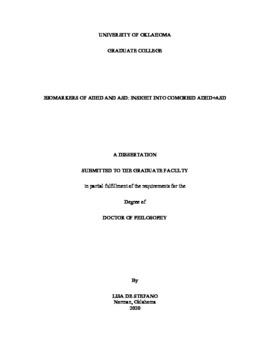| dc.contributor.advisor | Ethridge, Lauren | |
| dc.contributor.author | De Stefano, Lisa | |
| dc.date.accessioned | 2020-05-05T20:20:45Z | |
| dc.date.available | 2020-05-05T20:20:45Z | |
| dc.date.issued | 2020-05 | |
| dc.identifier.uri | https://hdl.handle.net/11244/324274 | |
| dc.description.abstract | Attention-deficit hyperactivity disorder (ADHD) and Autism spectrum disorder (ASD) are two of the most common neurodevelopmental disorders found in children and they show significant symptom overlap. Because both disorders are diagnosed based on behavioral observation, inferring which disorder (or combination of disorders) is causing symptoms in an individual child can be challenging for clinicians, particularly when an individual shows behaviors consistent with comorbid ASD+ADHD. The current study examined resting electroencephalography (EEG), as well as task-related EEG and behavior during a modified flanker task in 50 children (aged 6-12) with either a diagnosis of ADHD (n=17), ASD (n=5), both (comorbid ADHD+ASD, COM; n=8), or no clinical diagnosis (typically developing control, TDC; n=20). EEG and behavioral analyses began by comparing a set of features that have previously been used to discriminate single disorders from TDC. Next, the data from TDC and children with a single diagnosis (ASD-only, ADHD-only) were submitted to k-means cluster analysis to evaluate data-driven subgroups regardless of diagnosis. After recovery of the optimal number of clusters (3), the data from COM participants were sorted into the cluster in which they best fit. While none of the regularities found in the literature properly explain the relationships between ADHD, ASD, and COM participants, the use of cluster analysis suggested potential phenotypes that differ in Stimulus Engagement and Feedback Responsivity. These dimensions may have bearing on the efficacy of treatments that target dopaminergic systems, such as methylphenidate. Methods such as these may give insight into the neurobiological underpinnings of an individual’s symptoms, which has the potential to guide decisions about appropriate pharmacological treatment and behavioral interventions. | en_US |
| dc.language | en_US | en_US |
| dc.rights | Attribution-NonCommercial-NoDerivatives 4.0 International | * |
| dc.rights.uri | https://creativecommons.org/licenses/by-nc-nd/4.0/ | * |
| dc.subject | autism spectrum disorder | en_US |
| dc.subject | attention deficit hyperactivity disorder | en_US |
| dc.subject | biomarkers | en_US |
| dc.subject | eeg | en_US |
| dc.title | Biomarkers of ADHD and ASD: Insight into Comorbid ADHD+ASD | en_US |
| dc.contributor.committeeMember | Wenger, Michael | |
| dc.contributor.committeeMember | Gronlund, Scott | |
| dc.contributor.committeeMember | Song, Hairong | |
| dc.contributor.committeeMember | Yuan, Han | |
| dc.date.manuscript | 2020-04 | |
| dc.thesis.degree | Ph.D. | en_US |
| ou.group | College of Arts and Sciences::Department of Psychology | en_US |
| shareok.nativefileaccess | restricted | en_US |

